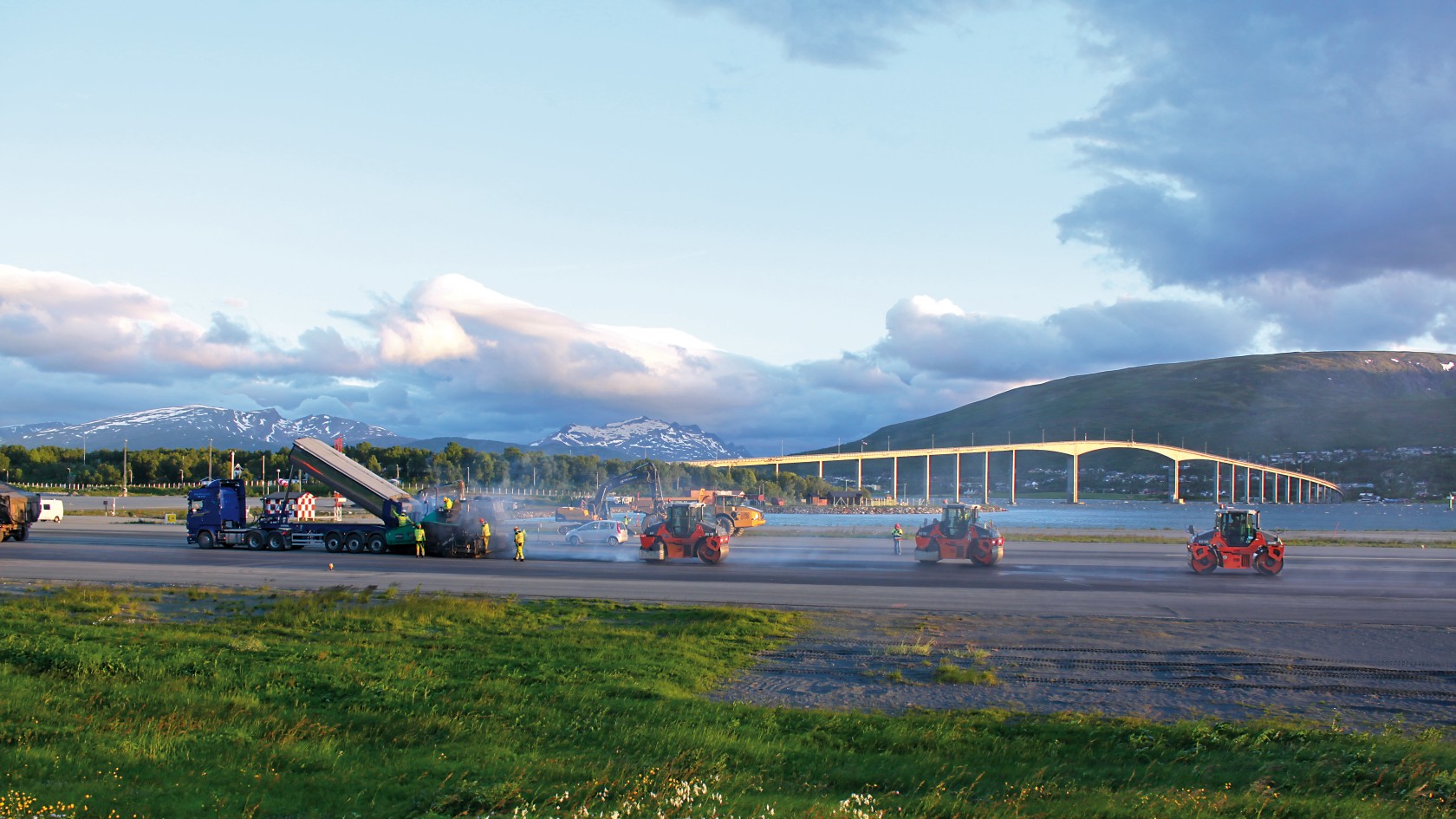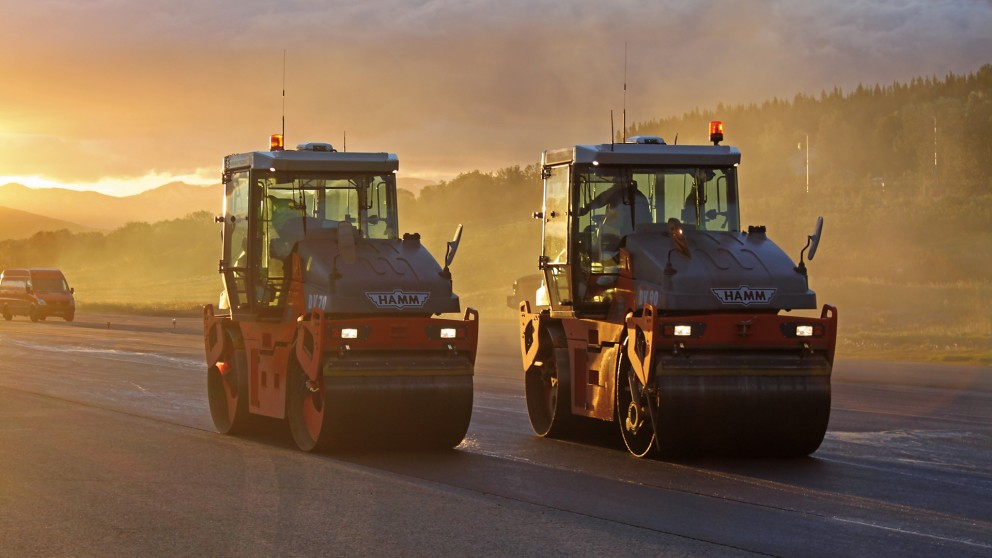Tromsø Airport


Tromsø Airport in the north of Norway is a hub that handles many domestic connections as well as fights to and from the neighbouring countries of Sweden, Finland and Russia. The runway is exposed to a constant, highly saline wind coming from the polar sea. The surface course must be repaired periodically, as was the case most recently in the summer of 2010. For the compaction work, the client Avinor asked to use combination rollers with oscillation. Why? This technology provides the only way to achieve high-quality compaction with no imperfections – despite the constant wind and temperatures under 10°C.
Work on the 2 km long runway at Tromsø Airport was carried out at night since the facility needed to stay in operation during the brief arctic summer. However, no special site lighting was required for this project despite working at night!
Since the sun never sets in Tromsø from mid-May until the end of July, the midnight sun provided sufficient light around the clock. Each night during the time between 22:00 and 06:00, the surface course was newly laid in a section with a length of 650 m and width of 4 m. Here, the contractor Lemminkäinen used a SUPER 1800-2 with a SprayJet module along with four Hamm rollers from the DV series for the compaction work.
The Scandinavian construction company Lemminkäinen already has solid experience with such projects in polar regions: In recent years they renovated the Norwegian airports of Værnes, Skagen, Bodø and Longyearbyen (Spitzbergen) as well as Rygge military airfield.
Tromsø has very special climatic conditions: The sea around this university town is ice-free year-round since it is warmed by the Gulf Stream. At the same time, however, a strong wind blows continuously. Because the customer was assuming the thin surface course would cool very quickly, Avinor ordered compaction with combination rollers using oscillation based on its familiarity with the benefits of this technology: A wider time window for the work and good compaction at the joints.
In order to have as much time as possible for the compaction work, the management team insisted on optimally tempered asphalt supplies. The temperature of the mixture, which is a polymer-modified asphalt, was monitored continuously. In addition, the paver worked on an overall width of only 4 m at a time with a relatively slow speed of about 4-5 km/h. Thanks to these measures and the use of oscillation compaction, Lemminkäinen was able to obtain outstanding compaction results.
“During our work with the oscillation rollers, we were impressed with the great flexibility on the site due to the wide temperature window. Moreover, we obtained the required compaction at a faster speed”, reported construction supervisor Gunnar Unstad from the company Lemminkäinen. Another benefit: When using oscillation, there is no damage to the adjacent areas that have already been compacted and cooled at the joints between the two asphalt surfaces.
Avinor and Lemminkäinen also swear by combination rollers in this application. Due to the kneading effect of the rubber wheels, the machines produce an outstanding bond between the new surface course and the existing layer. Moreover, it is possible to statically compact the asphalt while it is still very hot immediately behind the paver with the rubber wheels. Once the layer has cooled down somewhat, the oscillation is switched on to accelerate the compaction.
Lemminkäinen works almost exclusively with DV rollers from Hamm. The drivers are happy about this since they are big fans of these user-friendly machines.
One of the highlights of the all-wheel drive tandem rollers is their automatic seat rotation. This feature ensures that when the roller is reversed, the seat, including the operator’s console, is also rotated. In this manner, the driver is always facing in the direction of travel. The need to look backwards, which can be a source of back troubles, is a thing of the past with the DV rollers.
One of the operators from the Lemminkäinen team summed it up very well: “The DV’s seat rotation makes things a lot easier when you're working 8 to 10 hours per shift on this machine.”
Another feature of these rollers is the panoramic cabin with a view of the drums and rubber wheels. The glass cabin and innovative design of the machine frame are what makes this possible in the first place. “It took some smart engineers to figure out how to combine a clear view of the drums and the sprinkling at the same time. At this point, I don’t want to work on any other machine except the DV roller”, explained one of the men working at Tromsø Airport.
Each night on the runway, two tandem rollers and two combination rollers were deployed. Both of the tandem rollers were equipped with the HCQ GPS navigator with WLAN. “We’re using this measurement and documentation system from Hamm for two purposes: Documentation and operator support. The map on the panel PC provides a much better overview", explained construction supervisor Unstad. He is already familiar with HCQ GPS navigator from many other construction projects.
The basic principle is simple: Sensors are used to measure the compaction and the asphalt temperature. This information is then combined with the machine’s GPS position data. As a result, the operator sees a “compaction map” of the area still to be done in real time. In addition, the compaction and position data is saved using a PC on the roller.
In the system with WLAN that was used in Tromsø, the rollers continuously exchange data via radio. In this manner, each operator can see the overall status of the asphalt surface and then direct his machine to where the temperature is the lowest or the required number of passes has not yet been reached. At the airport construction site in the far north, the two “WLAN rollers” operated at the tail of the laying crew. This allowed the management team to be sure the work crew actually achieved the required level of compaction.
The system also offers comprehensive facilities for complete, reproducible documentation and evaluation of the compaction results. This is a tremendous benefit for the management team since they can verify the compaction results simply and without any complicated data transfers.
The experience gained here underscores the fact that compaction with HCQ GPS navigator saves time, ensures quality and prevents unhappy surprises during control measurements. This concept of self-monitoring in real time pays off since projects that are compacted in this manner will turn out to have significantly less defects, e.g. during the warranty period. Moreover, repairs will not be necessary until a longer time interval has elapsed.
Lemminkäinen was able to hand over the fully renovated runway to Avinor before the end of the midnight sun season. Unfortunately, the work was delayed a bit – almost three weeks were needed to repair the 2000 m long runway. However, the delay was due to the weather and not the construction machines. Non-stop rain impeded the work for many days.
Once the work was complete, construction supervisor Unstad praised the cooperation with the Wirtgen Group: “We received excellent support from Wirtgen Norway and the specialists at Hamm. They provided solid training to our team with HCQ and the WLAN system and were present for us during the entire construction time – around the clock.”
